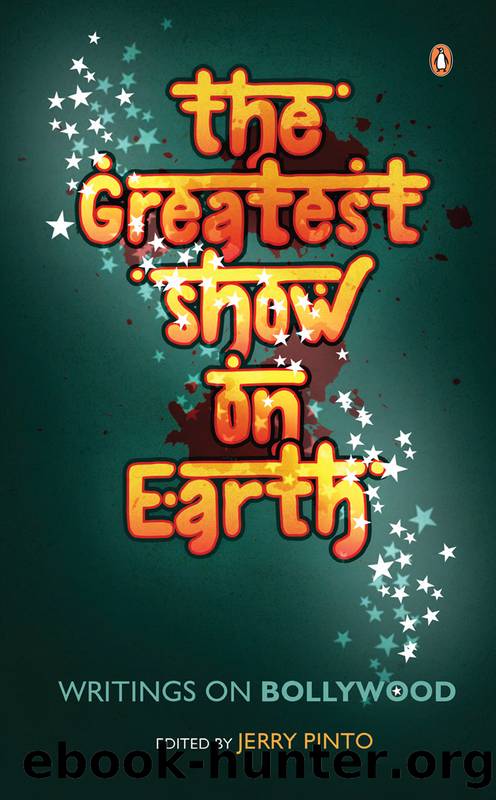The Greatest Show on Earth by Jerry Pinto

Author:Jerry Pinto [Pinto Jerry]
Language: eng
Format: epub
ISBN: 9789353052393
Publisher: Penguin Random House India Private Limited
Published: 2018-08-07T00:00:00+00:00
Sharaab nahin hoon magar ek nasha hoon
Main saare zamaane ke gham ki dawaa hoon.
(Alcohol I am not, but I am an intoxication
I am the cure of all the sorrows of the world.)
âLyrics from Helenâs song in
Adhikaar (1971)
I must have danced my way through more than a thousand films
in various languages, including Marwari and Bhojpuri.
âHelen, to Filmfare, on receiving a
Lifetime Achievement Award in 1998
With the exception of a few very silly films (Aap Beeti, Maya, Khoon Khoon, Jab Andhera Hota Hai), Helenâs name on the marquee meant that she was going to dance, which in turn generally meant a song. Not always, again, for there were some dances without songs as well (Hulchul, The Great Gambler). These sequences were primarily intended as eye candy but that was not the only function they performed.
The song in Hindi cinema has been paid much attention, most of it dismissive. It is regarded as a holdover from older art forms such as folk theatre and the Raas Leela and thus excused on the basis of its antiquity. It is scorned for its lack of realism, decried even by its exponents as ârunning around treesâ. However, a more reasonable way of looking at the song would be to see it as unreal in the rational senseâno hundred-piece orchestra plays when two people fall in love, nor can a woman walking through a cemetery be audible to everyone simultaneously in a huge mansionâbut certainly not meaningless in its symbolic reality.
Helenâs songs generally are described as cabarets. Historians of dance and other forms of public entertainment might cavil at the use of this term. For cabaret was born on 18 November 1881, when Rudolphe Salis opened his âChat Noirâ, a cabaret artistique, on Montmartre, Paris. His intention: âWe will satirize political events, enlighten mankind, confront it with its stupidity, cure those creeps of their ill-temper â¦â The original purpose of cabaret, therefore, was to shock the middle class (epater les bourgeois). It was more than a bunch of ladies showing off their frilly pantalettes or lack thereof. Skits were performed that lampooned authority; there were also other âactsâ, from contortionists to sword-swallowers to magicians. It was vaudeville with its underwear showing, a variety programme that teetered on the verge of being explicit, while never actually getting there. The frisson arose out of that unfulfilled promise.
Helen understood that. In The Britannica Encyclopaedia of Hindi Cinema, she says, â ⦠cabaret doesnât mean just wriggling your body as people thinkâitâs narration in dance. Paris nightclubs like Foleyâs and the Crazy Horse had these great cabarets.â Indeed, this was what she did in her best cabaretsâAa jaan-e-jaan from Intequam, Piya tu ab to aa ja from Caravan or Aaj ki raat koi aane ko hai from Anamikaâwhere a narrative is contained within the ambit of the song.
However, the word cabaret in the context of Indian cinema has come to mean a sexually suggestive dance performed by a woman for an audience that is either actually shown or is evident in the film.
Download
This site does not store any files on its server. We only index and link to content provided by other sites. Please contact the content providers to delete copyright contents if any and email us, we'll remove relevant links or contents immediately.
Naked as Nature Intended by Pamela Green(431)
The Filmmaker's Guide to Creatively Embracing Limitations: Not Getting What You Want Leading to Creating What You Need (for True Epub) by Pace William & Stobbe Ingrid(430)
30 Movies to Get You Through the Holidays by Roger Ebert(398)
Bond, James Bond by Brad Gilmore(368)
It's Only a Movie! by Haberski Jr. Raymond J(328)
Chinese films in focus II by Unknown(289)
How To Write A Novel The Easy Way Using The Pulp Fiction Method To Write Better Novels: Writing Skills by Jim Driver(283)
The Fellowship of the Knits: Lord of the Rings: The Unofficial Knitting Book by Tanis Gray(282)
Smartphone Cinema: Making Great Films with Your Mobile Phone by Bart Weiss(276)
Film Truth; November, 1920 by Anonymous(272)
Charles McGraw by Alan K. Rode(270)
The Greatest Show on Earth by Jerry Pinto(263)
The Making Of Horror Movies by Jennifer Selway(258)
Jafar Panahi: Interviews by Unknown(243)
The Garden in the Machine by Unknown(243)
Thomas Mann and Friedrich Nietzsche: Eroticism, Death, Music, and Laughter by Caroline Joan Picart(242)
The Reel Truth by Reed Martin(241)
Jurassic Park and Philosophy by Watkins Jessica Michaud Nicolas(237)
The Japanese Cinema Book by Hideaki Fujiki & Alastair Phillips(231)
